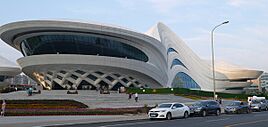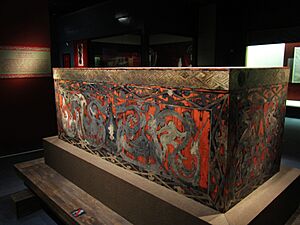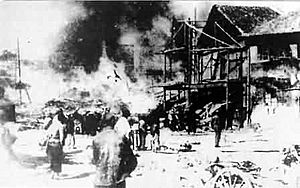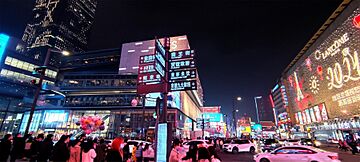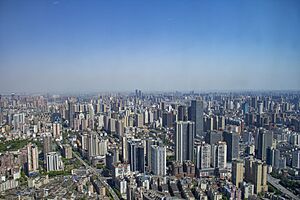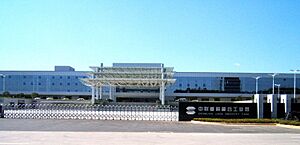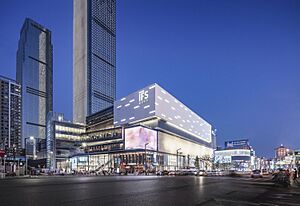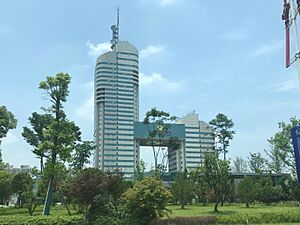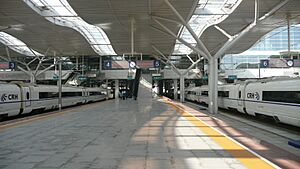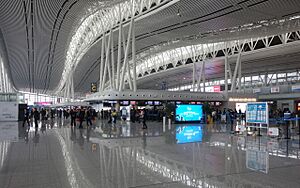Changsha facts for kids
Quick facts for kids
Changsha
长沙市
|
|
|---|---|
|
Prefecture-level city
|
|
|
Skyline with Xiang River
Aiwan Pavilion
Baoning Temple
Yuelu Academy
Young Mao Statue
Meixihu International Culture & Arts Center
|
|
| Nickname(s):
"星城" (Star City)
|
|
| Motto(s):
"心忧天下,敢为人先"
(Care About the World, Dare to Be Pioneers) |
|
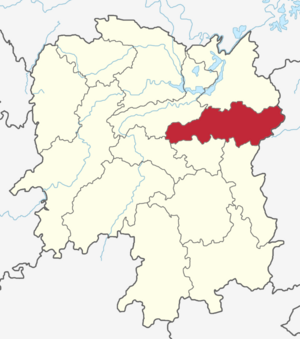
Location of Changsha City in Hunan
|
|
| Country | China |
| Province | Hunan |
| Municipal seat | Yuelu District |
| Divisions | 9 County-level divisions, 172 Township divisions |
| Government | |
| • Type | Prefecture-level city |
| • Body | Changsha Municipal People's Congress |
| Area | |
| • Prefecture-level city | 11,819 km2 (4,563 sq mi) |
| • Urban | 2,154.1 km2 (831.7 sq mi) |
| • Metro | 3,911.1 km2 (1,510.1 sq mi) |
| Elevation | 63 m (207 ft) |
| Population
(2022)
|
|
| • Prefecture-level city | 10,420,600 |
| • Urban | 5,980,707 |
| • Urban density | 2,776.43/km2 (7,190.92/sq mi) |
| • Metro | 10,500,000 |
| • Metro density | 2,685/km2 (6,950/sq mi) |
| • Rank in China | 19th |
| Ethnicity | |
| • Han | 99.22% |
| • Minorities | 0.78% |
| GDP | |
| • Prefecture-level city | CN¥ 1.397 trillion US$ 207.7 billion |
| • Per capita | CN¥ 133,992 US$ 19,925 |
| Time zone | UTC+08:00 (China Standard) |
| Postal code |
410000
|
| Area code(s) | 0731 |
| ISO 3166 code | CN-HN-01 |
| HDI (2016) | 0.817– very high |
| License Plate | 湘A 湘O (police and authorities) |
| City tree | Camphor tree |
| City flower | Azalea |
| Languages | Hunanese(Changsha dialect), Mandarin |
| Changsha | |||||||||||||||||||||||||||||||||
|---|---|---|---|---|---|---|---|---|---|---|---|---|---|---|---|---|---|---|---|---|---|---|---|---|---|---|---|---|---|---|---|---|---|

"Changsha" in Simplified (top) and Traditional (bottom) Chinese characters
|
|||||||||||||||||||||||||||||||||
| Simplified Chinese | 长沙 | ||||||||||||||||||||||||||||||||
| Traditional Chinese | 長沙 | ||||||||||||||||||||||||||||||||
| Hanyu Pinyin | Chángshā | ||||||||||||||||||||||||||||||||
| Xiang | [tsã13 sɔ33] () | ||||||||||||||||||||||||||||||||
| Literal meaning | "Long Sandbar" | ||||||||||||||||||||||||||||||||
|
|||||||||||||||||||||||||||||||||
| Former names | |||||||||
|---|---|---|---|---|---|---|---|---|---|
| Qing Yang | |||||||||
| Traditional Chinese | 青陽 | ||||||||
| Simplified Chinese | 青阳 | ||||||||
|
|||||||||
| Lin Xiang | |||||||||
| Traditional Chinese | 臨湘 | ||||||||
| Simplified Chinese | 临湘 | ||||||||
| Literal meaning | Overlooking the Xiang | ||||||||
|
|||||||||
| Tan Zhou | |||||||||
| Chinese | 潭州 | ||||||||
| Literal meaning | Eddy Prefecture | ||||||||
|
|||||||||
Changsha is the capital city of Hunan province in China. It's a huge city, home to over 10 million people, making it one of the most populated cities in China. Changsha is located along the Xiang River in northeastern Hunan.
This city is part of a larger area called the Greater Changsha Metropolitan Region, which also includes the cities of Zhuzhou and Xiangtan. In 2012, this region was named one of the 13 fastest-growing "mega-cities" in China. Changsha is also known for its rich history and culture. It's considered one of China's first "National Famous Historical and Cultural Cities."
Changsha has a history of city building that goes back more than 2,400 years! The name "Changsha" first appeared in ancient writings from before the Qin dynasty. Over the centuries, it has been an important center for trade, education, and even revolutionary movements. Today, Changsha is a modern city known for its strong economy, especially in making construction machinery. It's also a hub for research and new ideas, being the birthplace of amazing inventions like super hybrid rice and China's first supercomputer.
Contents
- What's in a Name?
- A Glimpse into History
- Where is Changsha?
- What's the Weather Like?
- How Changsha is Governed
- Changsha's Economy
- Fun Places to Visit
- People of Changsha
- Changsha's Culture
- Learning and Research
- Getting Around Changsha
- Changsha's Achievements
- International Friends
- Famous People from Changsha
- Astronomy Connection
- See also
What's in a Name?
The name Chángshā comes from Chinese words that mean "long sandy place." No one knows exactly how the name started. It was first mentioned over 3,000 years ago! Back then, a local leader sent a special gift called a "Changsha softshell turtle" to a king.
Long ago, the main city area was called Qingyang. Later, the capital of the Changsha Kingdom was known as Linxiang. This name means "looking over the Xiang River."
A Glimpse into History
Ancient Times
People started living and developing in the Changsha area around 3000 BC. There's good evidence that people lived here during the Bronze Age, making pottery and other items.
Later, during the Warring States period, the Chu state took control of Changsha. Its capital, Qingyang, became a key city in the south. Many ancient tombs from this time have been found, with over 3,000 discovered so far!
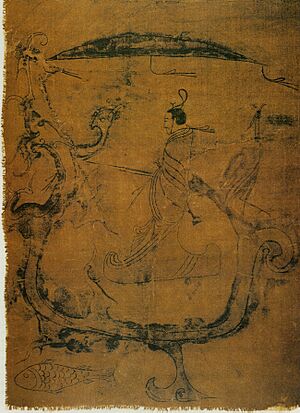
Under the Han dynasty, the city of Linxiang became the capital of the Changsha Kingdom. This kingdom helped control the local people and acted as a shield against other states. Around 202 BC, Linxiang had city walls to protect it.
The famous Mawangdui tombs were built between 186 and 165 BC. When they were explored in the 1970s, the body of Lady Xin Zhui was found incredibly well-preserved! These tombs also contained some of the oldest copies of important ancient writings.
Later Dynasties and Modern Era
During the Sui dynasty (around the 6th century), Changsha was renamed Tanzhou. It became an important trading center under the Tang dynasty. However, it faced challenges during rebellions.
In the early 900s, Changsha was the capital of the Nanchu state for about 50 years. This was the only time in history that an independent state was built in Hunan with Changsha as its capital.
Under the Song dynasty, the famous Yuelu Academy was founded in 976. This academy was one of the four most important private schools in China for over 1,000 years! It was rebuilt several times after wars. Today, Hunan University is a descendant of this ancient academy.
During the Qing dynasty, Changsha was the capital of Hunan province. It became a major market for rice and tea. In 1904, it opened for foreign trade, which brought new factories, churches, and schools.
Many important historical figures started their work in Changsha. Mao Zedong, who later founded the People's Republic of China, was a student and teacher here in the early 1900s.
During the Second Sino-Japanese War (1937–1945), Changsha was a very important city. It faced several attacks from the Japanese army. Before these attacks, a large fire in 1938 destroyed much of the city. This fire was started by commanders who feared the city would fall to the invaders.
After the war, Changsha slowly recovered. Since the 1990s, the city has grown very quickly. It is now one of the most important cities in central China.
Where is Changsha?
Changsha is located in the northeastern part of Hunan Province. It sits along the lower parts of the Xiang River. The city is about 230 kilometers (143 miles) from east to west and 88 kilometers (55 miles) from north to south.
The Xiang River is the main river in Changsha. It flows north for about 74 kilometers (46 miles) through the city. Many smaller rivers flow into the Xiang River, like the Liuyang River and Laodao River. The Xiang River divides the city into two parts: the eastern side is mostly for business, and the western side is more for culture and education.
Water Systems
Most of Changsha's rivers are part of the Xiang River system. There are 15 rivers that flow into the Xiang River within the city. Many smaller streams, over five kilometers long, also feed into these rivers. This creates a very complete and dense network of waterways. The rivers have a lot of water, which means plenty of water energy. They don't freeze in winter and carry little sediment.
Land Features
Changsha's land has a rich and complex geological history. All types of rock layers from different time periods are found here. The oldest layers formed about a billion years ago! About 600 million years ago, Changsha was covered by a shallow sea. Over time, the sea receded, and the land rose. About 140 million years ago, the sea was completely gone, and Changsha became dry land.
What's the Weather Like?
Changsha has a humid subtropical climate. This means it has hot, wet summers and cool, damp winters. The average temperature for the year is about 17.8°C (64°F). January is the coldest month, averaging 5.3°C (41.5°F), and July is the hottest, averaging 29.4°C (84.9°F).
The city gets about 1499 millimeters (59 inches) of rain each year. There are about 275 days without frost. Summers are long and very hot with lots of rain. Autumn is pleasant and usually the driest season. Winters are often cloudy and chilly, with light rain or occasional freezing temperatures. Spring is especially rainy and humid.
| Climate data for Changsha, (1991–2020 normals, extremes 1951–2010) | |||||||||||||
|---|---|---|---|---|---|---|---|---|---|---|---|---|---|
| Month | Jan | Feb | Mar | Apr | May | Jun | Jul | Aug | Sep | Oct | Nov | Dec | Year |
| Record high °C (°F) | 26.9 (80.4) |
30.6 (87.1) |
32.8 (91.0) |
36.1 (97.0) |
36.3 (97.3) |
38.2 (100.8) |
40.4 (104.7) |
40.6 (105.1) |
39.5 (103.1) |
35.1 (95.2) |
30.9 (87.6) |
24.9 (76.8) |
40.6 (105.1) |
| Mean daily maximum °C (°F) | 8.5 (47.3) |
11.5 (52.7) |
15.8 (60.4) |
22.4 (72.3) |
27.1 (80.8) |
30.3 (86.5) |
33.8 (92.8) |
32.7 (90.9) |
28.6 (83.5) |
23.6 (74.5) |
17.7 (63.9) |
11.5 (52.7) |
22.0 (71.5) |
| Daily mean °C (°F) | 5.1 (41.2) |
7.8 (46.0) |
11.7 (53.1) |
17.9 (64.2) |
22.6 (72.7) |
26.2 (79.2) |
29.6 (85.3) |
28.4 (83.1) |
24.2 (75.6) |
18.9 (66.0) |
13.2 (55.8) |
7.5 (45.5) |
17.8 (64.0) |
| Mean daily minimum °C (°F) | 2.7 (36.9) |
5.2 (41.4) |
8.9 (48.0) |
14.7 (58.5) |
19.3 (66.7) |
23.1 (73.6) |
26.2 (79.2) |
25.4 (77.7) |
21.1 (70.0) |
15.7 (60.3) |
10.0 (50.0) |
4.7 (40.5) |
14.7 (58.6) |
| Record low °C (°F) | −9.5 (14.9) |
−12.0 (10.4) |
−2.3 (27.9) |
1.9 (35.4) |
8.9 (48.0) |
13.1 (55.6) |
19.7 (67.5) |
16.7 (62.1) |
11.8 (53.2) |
2.4 (36.3) |
−2.8 (27.0) |
−10.3 (13.5) |
−12.0 (10.4) |
| Average precipitation mm (inches) | 74.5 (2.93) |
85.0 (3.35) |
149.2 (5.87) |
173.1 (6.81) |
201.7 (7.94) |
224.3 (8.83) |
162.8 (6.41) |
107.5 (4.23) |
86.6 (3.41) |
60.5 (2.38) |
77.7 (3.06) |
53.5 (2.11) |
1,456.4 (57.33) |
| Average precipitation days (≥ 0.1 mm) | 13.4 | 13.9 | 17.4 | 16.4 | 15.9 | 14.4 | 10.4 | 10.8 | 8.8 | 9.7 | 9.8 | 10.8 | 151.7 |
| Average snowy days | 4.9 | 2.9 | 0.4 | 0 | 0 | 0 | 0 | 0 | 0 | 0 | 0.1 | 1.9 | 10.2 |
| Average relative humidity (%) | 79 | 79 | 79 | 78 | 78 | 80 | 74 | 76 | 78 | 77 | 77 | 75 | 78 |
| Mean monthly sunshine hours | 64.7 | 66.5 | 83.5 | 110.0 | 137.1 | 141.4 | 226.7 | 208.5 | 151.2 | 134.0 | 112.4 | 96.8 | 1,532.8 |
| Percent possible sunshine | 20 | 21 | 22 | 28 | 33 | 34 | 54 | 52 | 41 | 38 | 35 | 30 | 34 |
| Source 1: China Meteorological Administration | |||||||||||||
| Source 2: NOAA | |||||||||||||
How Changsha is Governed
Changsha is divided into different areas for local government. It has six districts, one county, and two county-level cities. These divisions help manage the large population and many services needed for the city.
| Map | |||||
|---|---|---|---|---|---|
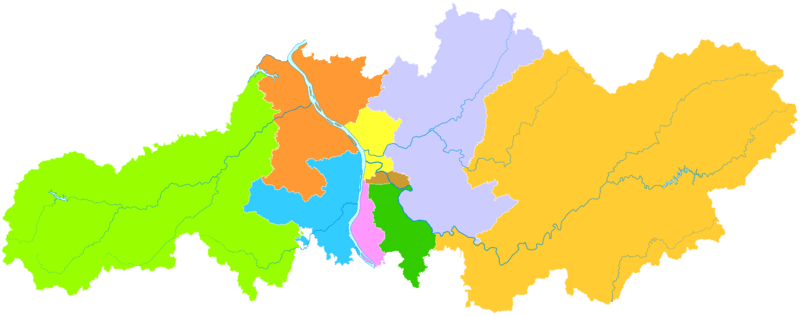
Furong
Tianxin
Yuelu
Kaifu
Yuhua
Wangcheng
Changsha
County Ningxiang
(city) Liuyang
(city) |
|||||
| Subdivision | Simplified Chinese | Pinyin | Pop.
(2010 census) |
Area (km2) | Dens. (/km2) |
| City Proper | |||||
| Furong District | 芙蓉区 | Fúróng Qū | 523,730 | 42 | 12,470 |
| Tianxin District | 天心区 | Tiānxīn Qū | 475,663 | 74 | 6,428 |
| Yuelu District | 岳麓区 | Yuèlù Qū | 801,861 | 552 | 1,453 |
| Kaifu District | 开福区 | Kāifú Qū | 567,373 | 187 | 3,034 |
| Yuhua District | 雨花区 | Yǔhuā Qū | 725,353 | 114 | 6,363 |
| Wangcheng District | 望城区 | Wàngchéng Qū | 523,489 | 970 | 540 |
| Suburban and rural | |||||
| Liuyang City | 浏阳市 | Liúyáng Shì | 1,278,928 | 4,999 | 256 |
| Ningxiang City | 宁乡市 | Níngxiāng Shì | 1,168,056 | 2,906 | 402 |
| Changsha County | 长沙县 | Chángshā Xiàn | 979,665 | 1,997 | 491 |
Changsha's Economy
Changsha is one of China's most economically advanced cities. In 2021, the city's economic output per person was over $20,000. This is considered a high-income level by global standards.
Changsha is a key city in the Yangtze River Economic Belt. It's also a "new first-tier city" in China. This means it's a very important city for business and development.
Changsha is known as the "Construction Machinery Capital of the World." This means it's a major center for making big machines used in building. Besides machinery, it also has strong industries in new materials, cars, electronics, and medicine.
Since the 1990s, Changsha's economy has grown very fast. It had the highest growth rate among major Chinese cities in the 2000s. In 2015, a special development area called the Xiangjiang New Area was created here.
Changsha is also famous for its media and publishing. It was the first Chinese city to be called a "UNESCO City of Media Arts." The Hunan Broadcasting System (HBS), a very popular TV station in China, is based here.
In 2017, Changsha's total economic output reached over one trillion yuan (about 154 billion US dollars). This made it the 13th city in China to reach this milestone. Many of the world's top 500 companies have offices in Changsha.
Changsha is also known for its lively night economy, ranking second in China for nighttime activities in 2021. The city is home to many billionaires, ranking 11th in Greater China for the number of wealthy residents. Experts predict that Changsha's economy will be among the world's top 50 largest cities by 2035.
Special Development Zones
Changsha has special areas called Development Zones to help businesses grow.
- The Changsha ETZ (Economic and Technological Development Zone) was started in 1992. It's a hub for high-tech, biology, and new material industries. It's close to major roads, the city center, and the airport.
- The Liuyang ETZ is a national center for biological industries. It focuses on biological medicine, information technology, and health food. It has over 700 businesses.
Fun Places to Visit
Tourism is a big part of Changsha's economy. The city is often ranked as one of China's best places for tourists.
Some popular spots include:
- The Yuelu Academy, an ancient school with a long history.
- The Changsha Meixihu International Culture & Arts Centre, a cool building designed by famous architects.
- The Young Mao Zedong statue on Orange Isle.
- Meixi Lake Park, a beautiful green space.
- Changsha IFS Tower, a very tall skyscraper.
- Window of the World, a theme park with miniature famous landmarks.
- Kaifu Temple, a peaceful Buddhist temple.
- Changsha Ice World, a fun place with ice activities.
Mount Yuelu
Mount Yuelu is on the west side of the Xiangjiang River. It's known for its beautiful nature. The mountain is home to many different kinds of plants, including ancient trees. It's a great place to explore and enjoy nature.
Orange Isle
Orange Isle is a large sandbar in the middle of the Xiangjiang River. It's sometimes called "China's First Continent." Here you can find the Mao Zedong Youth Art Sculpture and other interesting spots. The island was formed by river sand and rocks over many centuries.
Huaming Tower
Huaming Tower is the former home of Comrade Liu Shaoqi, a famous revolutionary leader and former president of China. It's a national tourist attraction and a protected historical site.
Hunan Museum
The Hunan Museum is one of China's top museums. It's the biggest history and art museum in Hunan Province. It holds over 180,000 important historical items, from ancient times to more recent dynasties.
People of Changsha
As of 2020, Changsha was home to over 10 million people. Most people living in Changsha are Han Chinese. There are also smaller groups of ethnic minorities, like the Hui, Tujia, and Miao peoples.
Changsha's Culture
Media and Entertainment
The Hunan Broadcasting System (HBS) is China's biggest TV station after CCTV. Its main office is in Changsha. HBS creates many popular TV shows, like Super Girl. These shows have helped create a lively entertainment scene in the city, with many singing bars, dance clubs, and theaters. Changsha has become a fun and modern city that attracts people from all over the world.
Food in Changsha
Changsha is famous for its hot and spicy Hunan cuisine. This style of cooking is very popular in the region. You can find many different kinds of delicious food here. For example, the popular snack chain Juewei Duck Neck, which has thousands of stores, started in Changsha.
The city also has its own unique "siu yeh" culture, which means late-night snacks. In 2008, a TV show called The Biggest Chinese Restaurant in the World showed the huge West Lake Restaurant in Changsha, which can seat 5,000 people!
Hunan's food culture has a long history. Ancient poems even mention dishes from Hunan. Over time, Hunan cuisine developed its special spicy and flavorful style.
Sports Scene
Changsha has one of China's largest sports stadiums, the Helong Stadium, which can hold 55,000 people. It's named after a famous Communist military leader. This stadium is the home field for the local football (soccer) team, Hunan Billows F.C..
Historical and Cultural Sites
The Hunan Provincial Museum in Changsha is a must-see. It has 180,000 important historical items, from ancient times to more recent dynasties.
Mawangdui is a famous ancient tomb site located east of Changsha. Many amazing items from the Han dynasty were found there. The tomb of Lady Xin Zhui at Mawangdui is especially famous because her body was found so well-preserved. Scientists could even figure out how she died!
Changsha is a "sister city" with St. Paul, Minnesota in the United States. They share cultural exchanges, like a Chinese garden being built in St. Paul based on Changsha's designs.
Learning and Research
New Ideas and Discoveries
Changsha is a hub for research and new ideas. It's where "super hybrid rice" was created, which helps feed many people. It's also the birthplace of China's first supercomputer, the Tianhe-1, and the first laser 3D printer. China's first medium-low speed maglev train line also started here.
In 2010, the National Supercomputing Changsha Center was opened at Hunan University. This made Changsha a major center for supercomputing in China.
Changsha is a very important city for scientific research in Asia. In 2023, it ranked 30th globally for scientific research output. It's also ranked highly for its technology clusters and attracting talented people. Since 2021, Changsha has been called "China's Leading Smart City."
Colleges and Universities
Changsha has a long history of excellent education. The Yuelu Academy, which later became Hunan University, was one of China's most famous ancient schools for over 1,000 years.
As of 2023, Changsha has 59 universities and colleges. This makes it one of the top cities in China for higher education. Many of these universities are highly ranked.
Top Public Universities Changsha is home to three "Project 985" universities: Central South University, Hunan University, and the National University of Defense Technology. This is a very high number for any city in China! Hunan Normal University is also a key national university. These four universities are part of China's "Double First-Class Construction" plan, meaning they are top-tier institutions.
Hunan University and Central South University are ranked among the world's top 300 universities. They are also among the top 50 universities globally for scientific research.
- Central South University
- Hunan University
- Hunan Normal University
- National University of Defense Technology
Other Important Public Universities
- Central South University of Forestry and Technology
- Changsha University of Science and Technology
- Hunan Agricultural University
- Hunan First Normal University
- Hunan University of Technology and Business
- Hunan University of Chinese Medicine
General Undergraduate Universities (Public)
- Changsha University
- Hunan University of Finance and Economics
- Hunan Police Academy
- Hunan Women's University
- Changsha Normal University
General Undergraduate Universities (Private)
- Changsha Medical University
- Hunan International Economics University
- Hunan Institute of Information Technology
Vocational and Technical Colleges
- Changsha Aeronautical Vocational and Technical College
- Changsha Social Work College
- Hunan Mass Media Vocational and Technical College
International Schools
- Changsha WES Academy
Notable High Schools
- Yali High School
- The High School Affiliated to Hunan Normal University
- Changjun High School
- The First High School of Changsha
Notable Primary Schools
- Changsha Experimental Primary School
- Datong Primary School
- Qingshuitang Primary School
- Shazitang Primary School
- Yanshan Primary School
- Yucai Primary School
- Yuying Primary School
Getting Around Changsha
Changsha has excellent transportation, including roads, rivers, trains, and planes. It's a major hub for business, tourism, and services.
The city has a huge bus system with over 100 routes. The Changsha Metro is growing, with two lines already open and more planned. A special maglev train connects the Changsha South Railway Station to the airport, making travel super fast!
Major highways connect Changsha to other cities across China. There are also three main bus terminals for longer trips. Ships transport goods from Xianing port on the Xiang River to places both in China and other countries.
The Changsha Railway Station in the city center offers train services to most Chinese cities. The Changsha South Railway Station is a newer station for high-speed trains. It opened in 2009 and has greatly increased the number of passengers.
The Changsha Huanghua International Airport is a big airport for the region. It has daily flights to major cities in China and direct flights to 45 international cities, including places like London, Frankfurt, and Sydney. In 2020, it was the 34th busiest airport in the world!
Changsha's Achievements
Changsha has received many honors and high rankings:
- It ranked 27th in the world for the number of tall buildings (over 150 meters) in 2021.
- The Changsha IFS Tower T1 was the 16th tallest completed building in the world in 2020.
- It was named China's 2nd Most Influential City for Nighttime Economy in 2022.
- It's one of China's "Happiest Cities."
- It became one of China's "new first-tier cities" in 2017.
- Ranked 32nd globally for "Science & Technology Cluster Cities" in 2024.
- Ranked 30th globally for scientific research output in 2023.
- It was the first Chinese city to be recognized as a "World Creative City in Media Arts" by UNESCO.
- It's considered a "Beta-" (global second-tier) city, like Manchester or Seattle.
- Changsha is projected to be among the world's top 50 largest economies by 2035.
International Friends
Sister Cities
Changsha has made friends with many cities around the world. These "sister city" relationships help promote cultural exchange and cooperation. By June 2018, Changsha had friendly ties with 49 cities in other countries.
Here are some of Changsha's sister cities:
 Brazzaville, Congo
Brazzaville, Congo Gumi, South Korea
Gumi, South Korea Kagoshima, Japan
Kagoshima, Japan Mogilev, Belarus
Mogilev, Belarus Mons, Belgium
Mons, Belgium New Haven, United States
New Haven, United States Jersey City, United States
Jersey City, United States Annapolis, United States
Annapolis, United States Saint Paul, United States
Saint Paul, United States Fribourg, Switzerland
Fribourg, Switzerland City of Auburn, Australia
City of Auburn, Australia Entebbe, Uganda
Entebbe, Uganda
Consulates
Some countries have official offices, called consulates, in Changsha to help their citizens and promote relations. ![]() Laos
Laos ![]() Malawi
Malawi
Famous People from Changsha
Many well-known people come from the Changsha area:
- Mao Zedong – The founder of the People's Republic of China.
- Zeng Guofan – A very important politician in the 1800s.
- Liu Shaoqi – A former President of China.
- Zhu Rongji – A former Premier of China.
- Hu Yaobang – A former leader of the Chinese Communist Party.
- Yang Kaihui – Mao Zedong's second wife.
- Huang Xing – A Chinese revolutionary leader.
- Tian Han – Wrote the words for China's national anthem.
- Wang Tao – A well-known economist.
- Zhou Guangzhao – A physicist who worked on important national projects.
- Zhou Jianping – An aerospace engineer and chief designer of China's space program.
- Lei Feng – A famous cultural hero in China.
- Liang Heng – A writer and scholar.
- Tan Dun – A famous composer who wrote music for movies like Crouching Tiger, Hidden Dragon.
- Zhang Ye – A popular singer.
- Xiong Ni – An Olympic gold medalist in diving.
- Li Xiaopeng – An Olympic gold medalist in gymnastics.
- Liu Xuan – An Olympic gold medalist in gymnastics.
- Meng Jia – A singer and actress, formerly in the K-pop group Miss A.
- Lay (entertainer) – A member of the K-pop group Exo.
- Qi Baishi – A famous painter.
- Shen Wei – A dancer and choreographer for the 2008 Beijing Olympics.
- He Jiong – One of China's most famous TV hosts.
- Lexie Liu – A singer-songwriter and rapper.
- Can Xue – A unique fiction writer.
- Xue Yiwei - A writer.
- Zhao Wendi – A footballer.
Astronomy Connection
In ancient Chinese star maps, the star Zeta Corvi represents Changsha in a special constellation.
See also
 In Spanish: Changsha para niños
In Spanish: Changsha para niños







